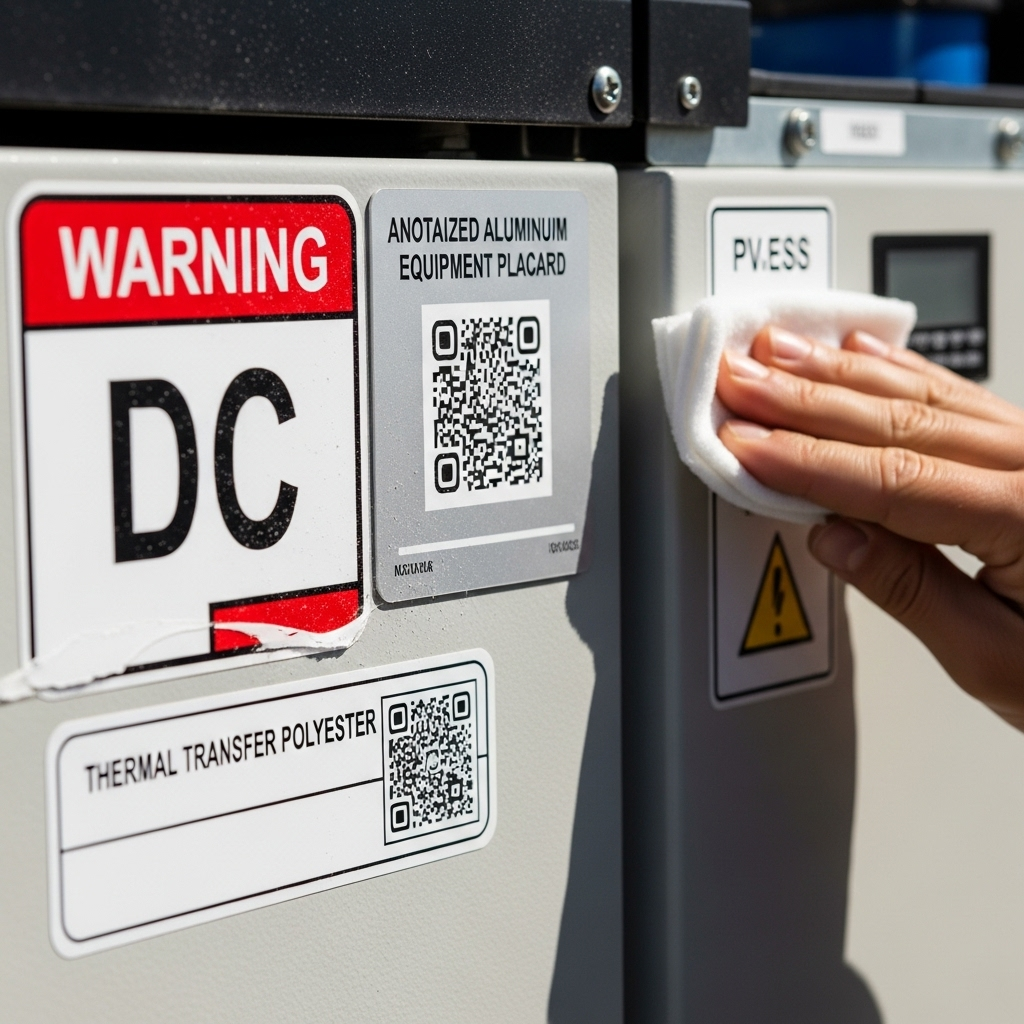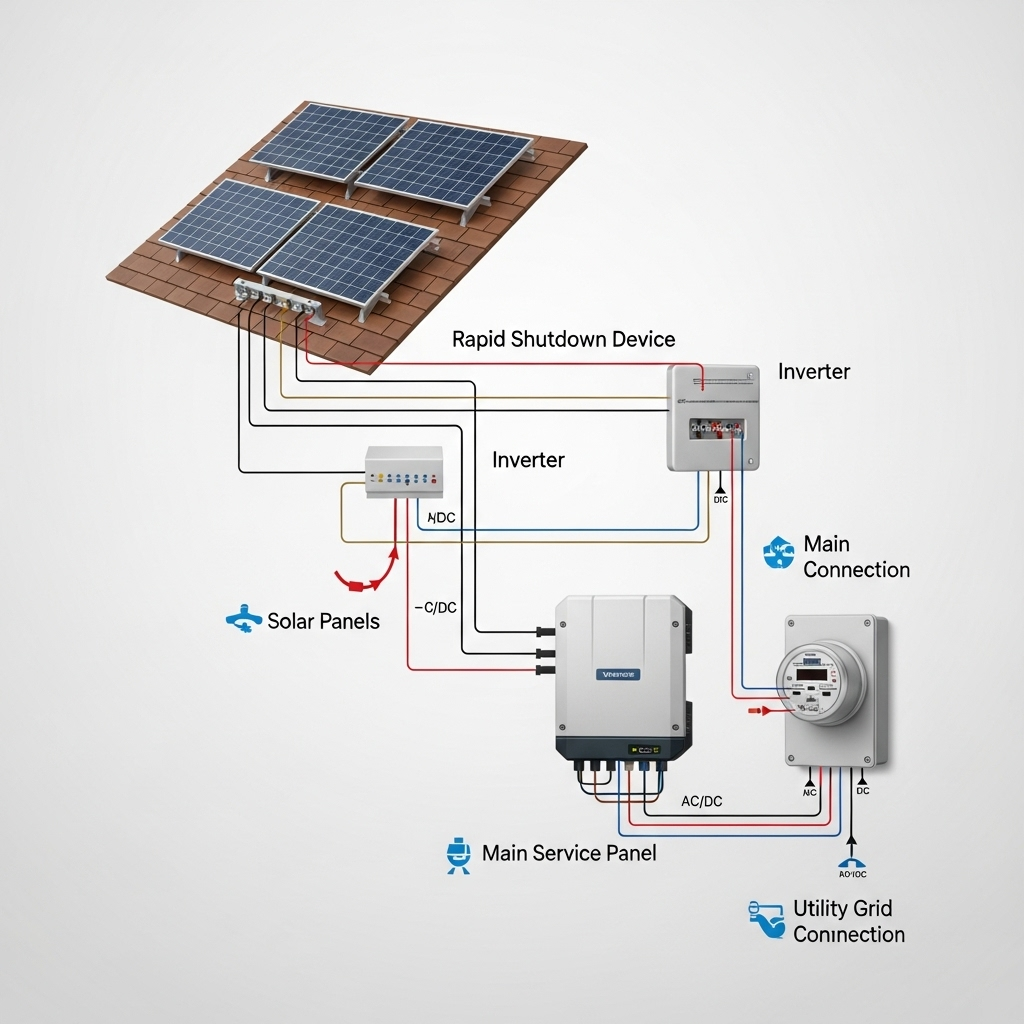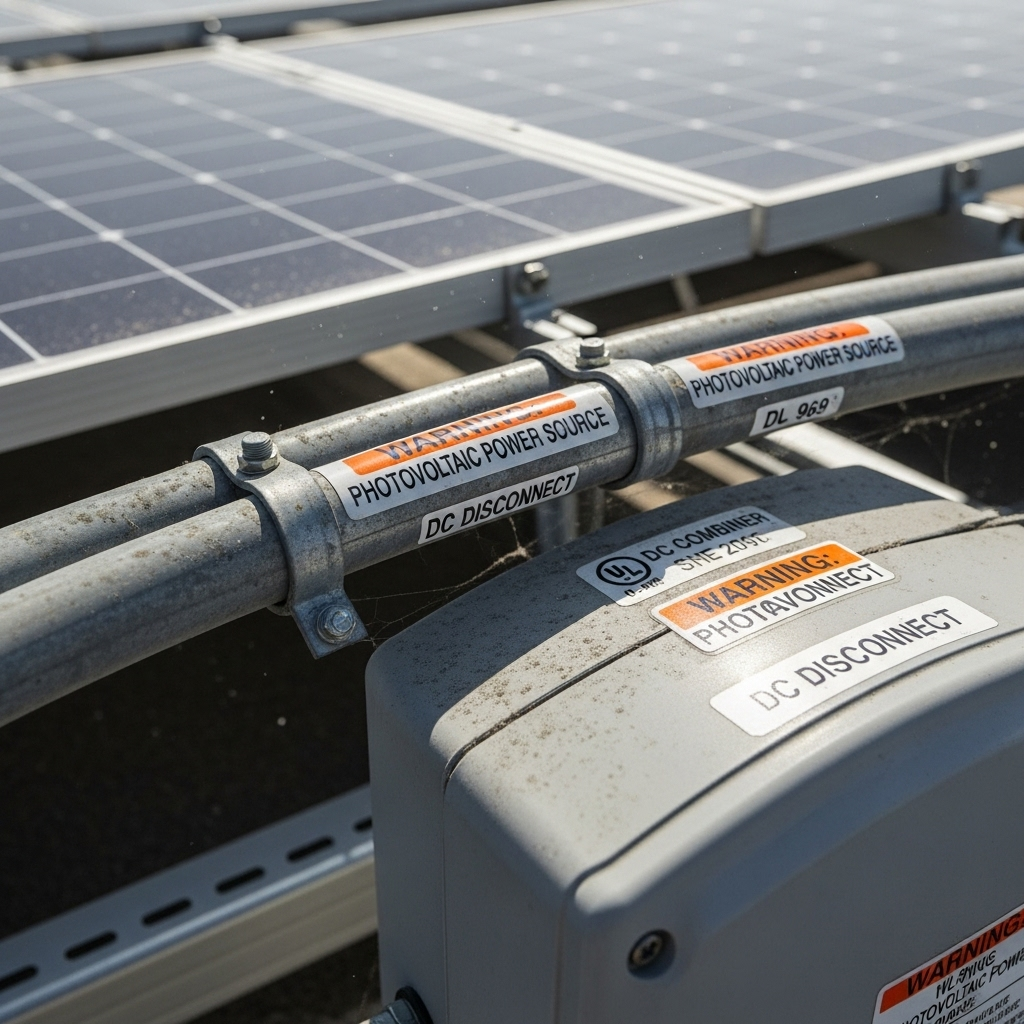Labels fail in the field long before arrays and batteries do. Faded text, peeling adhesives, and cracked laminates trigger red tags, rework, and delays. You can stop that with label designs built for sun, heat, salt, and hands-on maintenance.

Why red tags hit PV/ESS labels
Field failure modes
Most label issues trace to a few physical mechanisms:
- UV fade and chalking reduce contrast.
- Heat cycling and cold shrink crack films and inks.
- Salt, alkalis, and oils break down adhesives.
- Low-contrast graphics or small fonts fail readability checks.
- Wrong placement or surface prep leads to edge lift.
These modes intensify in coastal, desert, and high-altitude sites. Early PV work showed qualification tests did not separate products for various climates. As noted in the IEA PV roadmap, tests reduced early failures but did not quantify lifetime across environments. Apply that lesson to labels: design for climate, not just catalog specs.
Permitting pressure and practical obstacles
Project schedules strain under permitting and practical bottlenecks. The IEA energy investment 2023 analysis highlights slow approvals and field obstacles. Clear, durable labels reduce site questions and repeat visits. That trims risk while grids add more PV and storage, as summarized by energy.gov solar resources.
Design targets: start with the environment
Match materials and inks to the worst credible conditions at the label location, not just ambient weather.
| Stress | Common source | Design target | Notes |
|---|---|---|---|
| UV radiation | Full-sun roof, trackers | ISO 4892-2 1000–2000 h pass | Combine UV-stable ink + overlam |
| High temp | Dark metal enclosures | 90–120°C short-term rating | Polyimide or anodized aluminum excel |
| Thermal cycling | -40 to 85°C swings | 200 cycles with no edge lift | Use high-tack acrylic adhesive |
| Chemicals | Alkaline dust, cleaners, oils | 10+ rubs with IPA/NaOH no smear | Resin ribbon on polyester; laser on metal |
| Abrasion | Gloves, tools, hoses | Taber abrasion CS-10 1000 cycles | Hardcoat overlam or metal substrate |
| Salt/fog | Coastal sites | ASTM B117 500–1000 h pass | Prefer anodized aluminum + rivets |
Storage rooms add safety signage needs. IEA renewables integration notes that distribution planning and approval screens were built for lower DER levels. Clear ESS room signs and equipment labels speed checks and reduce site visits.
Materials and print methods that last
Substrate selection
- Polyester (PET), resin thermal transfer: strong UV resistance with overlam; 10+ years in many climates.
- Polyimide: high heat tolerance; use near inverters or inside cabinets with hot spots.
- Anodized aluminum, sealed dye or ceramic pigment: excellent UV, abrasion, and chemical resistance; 15–20 years service with mechanical fastening.
- Engraved phenolic or acrylic: good indoor/covered use; verify UV grade for sun exposure.
- Vinyl (PVC): easy to apply but poorer UV/heat aging; reserve for indoor or temporary tags.
Inks and imaging
- Resin thermal-transfer on polyester: best rub/chemical resistance among ribbon types.
- UV-cured inkjet on metals/rigid plates: thick, durable films; add clear coat in harsh sites.
- Laser etch on anodized aluminum or steel: no ink to fade; excellent for lifetime placards.
| Label type | Typical use | Service life (outdoor) | Fastening |
|---|---|---|---|
| Polyester + resin TTR + UV overlam | Combiner, conduit IDs | 8–12 years | High-tack acrylic |
| Anodized aluminum, laser/ceramic print | Main placards, disconnects | 15–20 years | Rivets/screws + sealant |
| Polyimide + resin TTR | High heat zones | 10+ years (covered) | Acrylic adhesive |
| Vinyl, eco-solvent print | Temporary notices | 1–3 years | Pressure-sensitive |
For storage cabinets using LiFePO4 batteries, place a permanent metal placard with chemistry, nominal voltage, Wh capacity, emergency contact, and shutdown method. Anecdotal field data shows crews rely on these details during outages.
Readability that passes every time
Contrast, size, and layout
- Use high contrast. White on red for DC hazard labels. Black on yellow for caution. Black on white for equipment data.
- Minimum text height 6 mm for gear-level reading; 9–12 mm for quick recognition at a distance.
- Sans-serif fonts, no condensed width. Avoid all caps for long lines.
- Add arrows, polarity icons, and circuit IDs in bold.
Color stability and standards
Specify pigment sets with UV stabilizers. Test for ΔE color change under ISO 4892-2. For critical hazards, add a hardcoat overlam or pick engraved/metal solutions.
QR codes and digital linkage
QR labels reduce guesswork. Link to as-builts, string maps, battery MSDS, and shutdown steps. Use short URLs with HTTPS, and keep a human-readable asset ID for offline use.
The Anern storage performance reference notes that storage performance varies with temperature and chemistry. Use that envelope to set label temperature ratings and to place QR content about safe charge/discharge ranges and maintenance windows.
As projects scale, clear digital documentation ties help compress approval cycles. This aligns with findings in the IEA energy investment 2023 summary on permitting and practical obstacles.
Testing and QA you can defend
Lab tests that matter
| Test | Method | Target | Pass criteria |
|---|---|---|---|
| Label permanence | UL 969 (or equivalent) | Outdoor use | No curl, legible, no edge lift |
| UV weathering | ISO 4892-2 | 1000–2000 h | ΔE < 5; contrast intact |
| Salt fog | ASTM B117 | 500–1000 h | No corrosion staining; adhesion OK |
| Thermal cycling | -40/85°C | 200 cycles | No cracking; no lift |
| Chemical rub | IPA/alkali wipe | 10–20 rubs | No smear; text sharp |
| Abrasion | Taber CS-10 | 1000 cycles | Legible; barcode scannable |
Record lot numbers for films, inks, and ribbons. Keep test photos and measurements in the turnover package. That reduces back-and-forth with AHJs and asset owners.
Field pilots
Install a pilot set in the harshest area. Inspect after 30, 90, and 180 days. Track ΔE, adhesion, and scan success for QR and barcodes. This small step avoids fleet-wide label replacements later.
Why the economics favor durability
Replacing labels costs more than materials. It triggers truck rolls, lift rentals, and possible plant downtime. IRENA and EIA materials show soft costs can dominate small upgrades; a label rework is purely soft cost. A stronger upfront spec is usually cheaper over the asset life.
| Item | Low-durability spec | High-durability spec |
|---|---|---|
| Label material + print | $0.80 each | $3.20 each |
| Expected service life | 2–3 years | 10–15 years |
| Replacement truck roll | $350 per visit | $0 |
| 10-year total (100 labels) | ≈$4,500–$7,000 | ≈$320 |
Estimates vary by region, but the direction is consistent.
Content that keeps crews and inspectors happy
PV equipment
- Combiner and DC feeders: circuit ID, voltage, max current, polarity, arc flash boundary if applicable.
- DC/AC disconnects: function, source, backfeed warnings, rapid shutdown notice where required.
- Conduits: direction arrows, circuit IDs every 3–6 m; use UV-stable wraps or snap-on covers.
ESS equipment
- Battery cabinets (LiFePO4): chemistry, nominal voltage, capacity (kWh), shutdown steps, contact number.
- PCS/inverter: AC output rating, fault-current notes, service clearances.
- Room signs: hazard pictograms, no-smoking, ventilation, and egress indicators; consider photoluminescent backing.
As storage scales, clarity becomes more valuable. The energy.gov solar pages and the Anern storage performance reference both emphasize how temperature and discharge profiles affect behavior. Labels should point users to safe operating envelopes.
Installation craft: make adhesion boring
- Clean: isopropyl alcohol wipe until no residue remains.
- Profile: smooth sharp edges; avoid raised welds or textured powder coat if possible.
- Apply: use a squeegee; avoid touching adhesive; apply between 10–38°C.
- Seal: on metal placards, use rivets or stainless screws; dab sealant to keep moisture out.
- Check: 24-hour adhesion check at corners; re-roll if needed.
Three field-proven patterns
Coastal C&I rooftop
Problem: vinyl wraps peeled in 18 months. Fix: anodized aluminum placards on disconnects, polyester wraps with hard overlam on conduits, salt-fog validated. Result: zero label-related red tags across two annual inspections.
High-desert ground mount
Problem: UV fade on printed PVC. Fix: resin thermal-transfer on polyester with UV overlam; QR for as-builts. Result: legibility intact after two summers; AHJ scanned QR to verify circuits.
Cold-climate microgrid
Problem: brittle films at -30°C. Fix: polyimide labels inside cabinets; exterior plates in anodized aluminum, mechanically fastened. Result: no cracking through two winters.
Procurement and documentation
- Specify a recognized label system (e.g., tested to UL 969 or equivalent) and demand certificates of compliance.
- Request weathering data and resin ribbon pairing recommendations for each film.
- Require lot traceability and sample retains for two years.
- Include label drawings in the as-built set and link them via QR on the main placard.
Market stresses and cost shifts have raised attention to practical site risks. The 2022–2023 cost context noted in IEA energy investment 2023 underscores the value of avoiding repeat field work.
Wrap-up
Durable PV/ESS labels do not happen by chance. Pick the right substrate, ink, and adhesive for the environment. Prove it with lab tests and a short field pilot. Map content to hazards and assets, then back it with QR-linked documents. You will cut red tags, speed approvals, and make operations safer.
Disclaimer: Code references and compliance notes here are for general information only and do not constitute legal advice. Always verify with current NEC/NFPA/IFC language and your AHJ.
FAQ
What label material lasts longest outdoors?
Anodized aluminum with laser or ceramic imaging resists UV, heat, chemicals, and abrasion best. For wraps and small markers, polyester with resin thermal-transfer ink plus a UV overlam holds up very well.
How can I prevent peeling on textured or powder-coated enclosures?
Use mechanical fastening for main placards. For stickers, select high-tack acrylic adhesive, warm the surface to 15–25°C, and apply firm pressure with a squeegee. Round label corners to reduce edge lift.
Are QR codes acceptable on safety labels?
Use QR as a supplement, not a substitute for critical hazards. Put the required text on the label, then add a QR linking to as-builts, shutdown steps, and MSDS. Keep a human-readable asset ID as backup.
What size should text be on outdoor equipment labels?
Use at least 6 mm character height on equipment you can approach, and 9–12 mm for quick recognition at a distance. Ensure high contrast and avoid glossy finishes that glare in sun.
How do storage performance limits affect label specs?
Battery performance and safety margins shift with temperature and chemistry. Align label temperature ratings and placement with the battery’s operating envelope and link QR content to maintenance and limits, as noted in the Anern storage performance reference.





Leave a comment
All comments are moderated before being published.
This site is protected by hCaptcha and the hCaptcha Privacy Policy and Terms of Service apply.